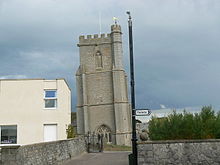St Andrew's Church, Burnham-on-Sea
| St. Andrew's Church | |
|---|---|
 |
|
| General information | |
| Town or city | Burnham-on-Sea |
| Country | England |
| Construction started | 1305 |
| Completed | 1314 |
 |
|
|
Somerset
|
|
| Location |
Burnham-on-Sea Somerset England |
|---|---|
| Coordinates | 51°14′23″N 2°59′53″W / 51.239594°N 2.998141°WCoordinates: 51°14′23″N 2°59′53″W / 51.239594°N 2.998141°W |
| Year first constructed | 1700s as light tower |
| Construction | stone church tower |
| Tower shape | square parallelelpiped church tower with light |
| Markings / pattern | unpainted tower |
| Height | 11 metres (36 ft) |
| Focal height | 12 metres (39 ft) |
| Range | 3 nautical mile |
| Characteristic | F R |
| Admiralty number | A5572.1 |
| NGA number | 6180 |
| Managing agent | St. Andrew's Church |
| Heritage |
Grade I listed building |
|
[]
|
|
St Andrew's Church is the Church of England parish church of Burnham-on-Sea in the English county of Somerset. Of medieval origins, the church is a grade I listed building, well known for its leaning tower.
There has been a church on this site since the late 11th century. Between 1305 and 1314 the original church was either replaced or enhanced; the parts of that church that still stand are the south transept, the south door arch, the holy water stoop and the consecration cross. The tower dates from the late 14th century, and the nave from the late 14th/early 15th century. The north aisle and gallery were added in 1838, and the chancel arch modified at this time. The chancel itself was remodelled in 1878.
The leaning tower, 78ft high, gets a lot of attention from tourists. Apparently if a plumb line is dropped from the north side of the tower it would fall 3 feet away from the building. This major leaning is believed to be caused by the poor foundations.
During the 18th century a light was placed on the tower to guide fishing boats into the harbour. A local vicar, either John Goulden in 1764 or Walter Harris in 1799, raised a subscription amongst the local population to replace the light on the church. A four storey round tower was built next to the church, being completed in 1801. This was taken over and improved by Trinity House, in 1829. Funds from the sale were used by the vicar, Rev David Davies, to improve the area in an attempt to create a spa town. Trinity House operated the lighthouse until 1832 when it became inactive and was replaced by the High and Low lighthouses. The round tower was later shortened to two storeys, to prevent any confusion with the High Lighthouse.
...
Wikipedia

